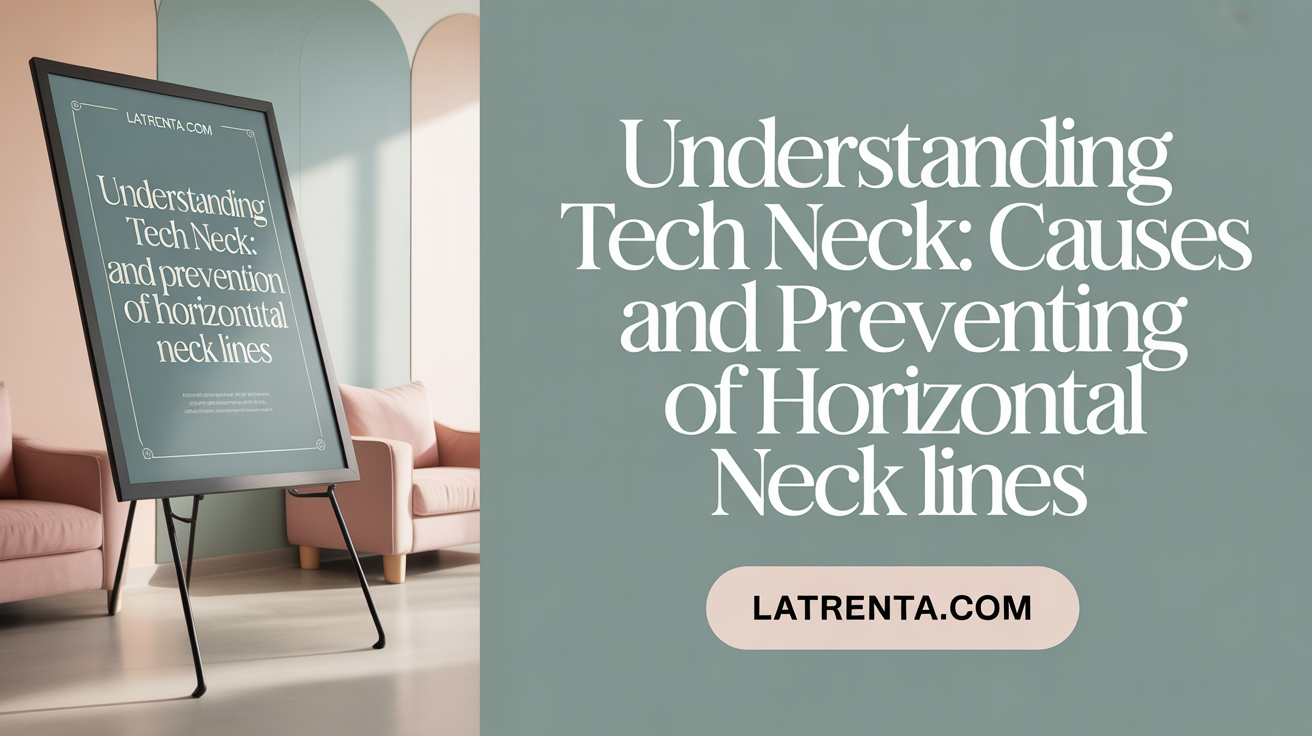Understanding Tech Neck and Its Impact on Neck Wrinkles
Tech neck, a modern skin aging concern stemming from prolonged device use, manifests as horizontal neck wrinkles and skin laxity. This article explores the causes, aesthetic treatment options, and scientific data supporting diverse interventions, with emphasis on device-assisted therapies and clinical outcomes in neck rejuvenation.
Defining Tech Neck and the Development of Horizontal Neck Lines
 What is tech neck and can it cause wrinkles?
What is tech neck and can it cause wrinkles?
Tech neck is a condition resulting from prolonged looking down at electronic devices like smartphones, tablets, or laptops. This habitual posture stresses the neck muscles, which become short and weak over time. As a consequence, the skin and underlying tissues can sag prematurely, leading to visible signs of aging such as wrinkles and even a double chin.
Horizontal lines on the neck, often called neck wrinkles, are mainly caused by intrinsic and extrinsic factors. Natural aging reduces collagen and skin elasticity, making the skin more fragile and prone to wrinkling. Repeated movements and poor posture, especially from habits like continually looking down, also play a significant role in forming creases that become permanent over time.
Sun exposure further accelerates aging through UV rays that break down collagen and damage skin cells. Genetics influence how quickly and severely these lines develop, while habits like smoking worsen collagen degradation.
Posture is crucial in the development of these horizontal neck lines. Constant downward head positions create folds and stress that contribute to wrinkle formation. Preventing or delaying these lines involves maintaining good posture, using sunscreens, keeping the skin well-hydrated, and adopting healthy lifestyles. Initially, adjusting device use positions and practicing neck exercises can help minimize the risk.
Existing lines can be treated with various medical procedures, including topical skincare with retinol, non-invasive energy devices like radiofrequency and laser treatments, or minimally invasive procedures such as filler injections and thread lifts. For overall prevention, emphasizing ergonomic workspace setup and skincare routines remains fundamental.
Topical and Skincare Solutions Targeting Tech Neck Wrinkles

How effective is retinol in treating tech neck?
Retinol is a well-known ingredient in anti-aging skincare, and it can play a significant role in improving tech neck wrinkles. Its primary function is to stimulate collagen production in the skin, which enhances elasticity and helps soften fine lines.
For tech neck, retinol works gradually to improve the skin’s texture and reduce the appearance of creases caused by sustained downward head posture. With consistent use, the skin can become firmer and more resilient, contributing to a more youthful appearance.
However, because the skin on the neck is thinner and more fragile than on the face, retinol alone might not be sufficient to address deeper or more prominent wrinkles. It is often recommended to combine retinol with other supportive ingredients like peptides, which promote skin regeneration, and hyaluronic acid, which hydrates and plumps the skin.
Aside from topical agents, adopting lifestyle habits such as adjusting device positioning, practicing good posture, and applying broad-spectrum sunscreen are crucial in preventing further deterioration of neck skin. These measures complement topical treatments and form a comprehensive approach to managing tech neck wrinkles.
Overall, retinol can significantly contribute to the improvement of neck skin’s appearance, especially when integrated into a dedicated skincare routine and combined with preventive strategies.
Non-Surgical and Minimally Invasive Procedures for Neck Wrinkles

Overview of injectable treatments: fillers, Botox, and combined therapies
Injectable treatments are popular options for addressing neck wrinkles and skin laxity. Dermal fillers, particularly high-viscosity hyaluronic acid like CPM-HA, are used to hydrate and plump the skin, smoothing out static wrinkles. Studies have shown that fillers can provide significant, sustained improvement in wrinkle severity, with effects lasting up to 36 weeks.
Botox or neuromodulators are also employed, especially for dynamic lines resulting from muscle activity. When combined with fillers, these injectables enhance overall neck rejuvenation. A synergistic effect is often achieved, leading to more natural and youthful outcomes.
Thread-lifting techniques and biocompatible materials
Thread-lifting is an effective minimally invasive procedure that uses absorbable sutures, such as Poly p-dioxanon (PPDO), to lift and tighten sagging neck skin. The technique involves precise placement of threads to stimulate collagen production and support tissue restructuring.
The innovative Diamond technique uses a specialized acetate device to guide injections of calcium hydroxyapatite (CaHA), hyaluronic acid, and diluted botulinum toxin, which reinforce skin firmness and reduce wrinkles. Results include dermal densification and improved skin quality, with minimal adverse effects, making it a preferred method for moderate laxity.
Minimally invasive surgeries like Renuvion for moderate skin laxity
For more significant skin sagging, minimally invasive surgical options such as Renuvion combine radiofrequency energy with helium plasma to induce skin tightening. These procedures are performed via small incisions and require minimal downtime.
Renuvion effectively addresses moderate to advanced laxity and wrinkles, improving neck contour and skin firmness. Similar approaches include RF microneedling and focused ultrasound devices, which stimulate collagen remodeling and enhance skin elasticity.
Comparative efficacy and patient outcomes with injectables and threads
Both injectables and thread-lifting procedures have demonstrated positive outcomes in clinical studies. Hyaluronic acid fillers have shown high patient satisfaction, with improvements sustained over several months. Thread-lifting offers measurable tissue tightening, with results visible within weeks.
Patients tend to experience minimal discomfort and transient side effects such as edema or erythema, which resolve quickly. The choice between treatments depends on the severity of the concern, patient preference, and skin condition.
The integration of energy-based devices further enhances the effectiveness of non-surgical options, promoting collagen growth, improving skin tone, and reducing wrinkles.
What are the best non-surgical aesthetic treatments for tech neck and neck wrinkles?
Non-surgical treatments that effectively improve tech neck and neck wrinkles include Botox injections, dermal fillers, radiofrequency (RF) skin tightening, laser treatments, fractional laser therapy, microneedling radiofrequency ablation, and High-Intensity Focused Ultrasound (HIFU). These methods stimulate collagen production and tighten the skin.
Energy-Based Device Therapies: Radiofrequency, Ultrasound, and Laser Technologies
How do device-based procedures like radiofrequency and HIFU contribute to neck skin rejuvenation?
Device-based treatments such as radiofrequency (RF) and High-Intensity Focused Ultrasound (HIFU) play a vital role in non-surgical neck rejuvenation by utilizing controlled thermal energy to stimulate collagen production and tissue remodeling.
RF devices work by delivering radio waves into the skin, heating the dermal layers to approximately 60–65°C. This controlled heating causes the collagen fibers to denature and contracts, which tightens the skin. Over time, the stimulation of fibroblasts—cells responsible for collagen synthesis—leads to increased skin elasticity and firmness.
HIFU, on the other hand, uses focused ultrasound energy to target deeper tissues, including the subdermal fat layer and the superficial muscular aponeurotic system (SMAS) at depths ranging from 1.5 to 4.5 mm. This thermal coagulation induces tissue contraction and stimulates new collagen growth, providing a lifting and tightening effect.
Both treatments emphasize precise temperature control—usually around 60–65°C—to maximize efficacy while reducing the risk of adverse effects. These technologies promote neocollagenesis, improving skin laxity and reducing wrinkles without the need for surgery.
Clinical evidence on effectiveness and safety of device-based treatments
Multiple studies demonstrate that RF and HIFU treatments are effective and safe for neck skin rejuvenation. Patients consistently report improvements in skin firmness, reduction in wrinkles, and a more youthful appearance.
For example, energy-based devices like the InMode AccuTite and Evoke systems can achieve noticeable tightening in a single session lasting 30 to 45 minutes. Clinical trials and patient surveys show high satisfaction rates, with over 50% experiencing more than a 50% improvement in wrinkle severity.
Adverse effects are typically mild and transient, including temporary erythema, edema, and swelling. Histological analyses reveal increased dermal density, collagen deposition, and improved skin thickness after treatments. Importantly, the safety profile is favorable, with few reports of serious complications such as burns or nerve injury.
FDA-approved and emerging technologies like Sofwave and Endolift
Sofwave™ utilizes Synchronous Ultrasound Parallel Beam technology (SUPERB) to non-invasively heat the deep dermal layers and stimulate collagen synthesis. FDA-approved for neck, submental, and brow lifting, Sofwave delivers energy in a single 45-minute session with minimal downtime. Results generally appear within weeks, continuing to improve over three months.
Emerging techniques, such as Endolift laser technology, involve minimally invasive laser microfibril delivery to tighten skin and enhance elasticity. These procedures can effectively treat more pronounced signs of aging, providing significant improvements with minimal recovery time.
Histological outcomes and treatment protocols for neck rejuvenation
Histological studies indicate that RF and HIFU therapies promote collagen realignment, thickening the dermis, and stimulating neocollagenesis and elastin production. Protocols typically involve multiple sessions spaced one month apart, tailored to individual patient needs.
Treatment benefits persist for several months post-therapy, with sustained improvements observed in skin firmness, texture, and wrinkle reduction. Combining energy-based treatments with other modalities like fillers and neurotoxins can further enhance neck rejuvenation outcomes.
| Technology | Depth Targeted | Key Benefits | Notable Features |
|---|---|---|---|
| RF (Radiofrequency) | Dermis (1–6 mm) | Skin tightening, collagen stimulation | Precise temperature control, minimal downtime |
| HIFU (High-Intensity Focused Ultrasound) | Subdermal & SMAS (1.5–4.5 mm) | Skin lifting, tissue contraction | Deep tissue focus, non-invasive |
| Sofwave™ | Deep dermis | Collagen boost, lifting | FDA-approved, single session |
| Endolift | Microfibril delivery | Skin tightening, elasticity | Minimally invasive, targeted |
Effective neck rejuvenation using these energy-based devices continues to evolve, supported by ongoing research and technological improvements, offering patients safe and effective options for a more youthful neck appearance.
Scientific and Clinical Evidence Supporting Neck Wrinkle Treatments

What scientific and clinical evidence supports the safety and efficacy of treatments for neck wrinkles?
Numerous studies and trials have demonstrated that various non-invasive and minimally invasive treatments effectively improve neck wrinkles and skin laxity. Technologies such as High-Intensity Focused Ultrasound (HIFU), Radiofrequency (RF), and Microfocused Ultrasound with Visualization (MFU-V) are well-supported by scientific research.
HIFU and RF devices function by delivering controlled thermal energy to stimulate collagen production, resulting in skin tightening. Clinical data indicate high satisfaction rates among patients, with large retrospective studies reporting up to 96.4% improvement in skin tightness. Additionally, three-dimensional imaging confirms measurable lifting effects, particularly in the neck area. These treatments typically exhibit minimal transient side effects, such as erythema (redness) and swelling, which resolve quickly.
MFU-V, one of the most studied energy-based devices, has over 50 clinical trials backing its efficacy. It offers a precise, non-invasive approach to lifting and rejuvenating the neck’s skin. The FDA has cleared MFU-V for these purposes, further validating its safety profile.
Histological and imaging analyses corroborate clinical findings, revealing increased dermal density, new collagen synthesis, and improved skin elasticity following therapy. These results reflect a reliable combination of scientific evidence and real-world patient outcomes.
Overall, the accumulating data underscore that these energy-based modalities are safe, effective, and applicable for treating mild to moderate signs of neck aging, especially when administered by trained practitioners. These advances continue to build confidence in their long-term benefits, making them integral to modern aesthetic practice.
Comparative Analysis of Aesthetic Modalities for Neck Wrinkles

How do RF+PRP, Botox, fillers, laser, and ultrasound treatments compare?
Various treatments are available for neck wrinkles, each with unique benefits and limitations. Radiofrequency combined with Platelet-Rich Plasma (RF+PRP) stands out for its ability to stimulate collagen production and improve skin elasticity, leading to noticeable results that last at least six months. Studies have shown that RF+PRP can significantly reduce wrinkle severity with a 100% responder rate, making it highly effective for skin tightening and volume restoration.
Botox, on the other hand, mainly targets dynamic wrinkles caused by muscle activity. It temporarily relaxes muscles, smoothing out lines but does not enhance skin quality or collagen levels. Dermal fillers, such as hyaluronic acid, are effective for restoring volume and smoothing static wrinkles but do not address skin laxity.
Laser treatments and high-intensity focused ultrasound (HIFU), including devices like Sofwave™, promote collagen remodeling and skin tightening through energy-based actions. They improve skin texture, reduce wrinkles, and provide non-invasive lifting over time.
What are the advantages and limitations of each approach?
| Treatment Type | Advantages | Limitations | Ideal Use |
|---|---|---|---|
| RF+PRP | Durable results, collagen boost, skin elasticity | Requires multiple sessions, some swelling or erythema | Skin laxity, superficial wrinkles |
| Botox | Quick, effective for dynamic lines | Temporary, no skin texture improvement | Small, expression-related wrinkles |
| Fillers | Restores volume, instantly smooth | Limited for skin laxity, potential to cause lumps | Static wrinkles, volume loss |
| Laser/HIFU | Non-invasive skin tightening | Multiple treatments, variable results | Skin laxity, fine lines |
How long do results last, and what should be considered?
The longevity of treatment results varies. RF+PRP can last several months up to a year, with some patients experiencing extended effects due to ongoing collagen stimulation. Botox effects typically last 3-6 months, requiring re-treatment. Fillers offer immediate results, lasting from 6 months to 2 years depending on the product used, while laser and ultrasound treatments generally provide results lasting 6-12 months.
How to tailor treatments to individual needs and severity?
Selecting the appropriate treatment depends on the degree of neck aging, patient goals, and safety considerations. For mild skin laxity with static wrinkles, RF+PRP provides a long-lasting, minimally invasive option. Moderate to severe laxity might benefit from combined therapies, including energy devices plus fillers or neuromodulators. For dynamic wrinkle correction, Botox is preferred for targeted muscle relaxation. Advanced cases with significant sagging may require surgical intervention.
A comprehensive assessment, including clinical examination and patient preferences, is essential to develop a personalized treatment plan that effectively addresses individual aging signs, maximizes safety, and achieves natural-looking results.
Holistic Management: Posture, Prevention, and Emerging Home-Use Devices

Importance of ergonomics and posture for prevention
Maintaining proper posture is vital in preventing tech neck and associated horizontal neck wrinkles. Prolonged looking down at devices like phones and tablets exerts stress on neck muscles, creating folds in the skin that develop into wrinkles.
Adjusting the workspace and device positioning can significantly reduce strain. Elevating screens, using ergonomic furniture, and taking regular breaks help maintain a neutral neck posture. These simple changes are effective preventative strategies.
Lifestyle and skincare recommendations
In addition to posture adjustments, lifestyle habits play a crucial role in managing neck aging. Consistent use of skincare ingredients like retinol, peptides, antioxidants, and hyaluronic acid can improve skin elasticity and hydration.
Applying broad-spectrum sunscreen and covering the neck area during daily routines further protect against UV-induced skin damage. Regular neck exercises and good sleep hygiene, including reducing blue light exposure before bed, support skin health and slow aging signs.
Role and evidence of home-use LED devices and topical regimens
Recent studies from reputable sources show that home-use LED devices can effectively improve neck wrinkles. These devices, utilizing light therapy, stimulate collagen production without discomfort or downtime.
For example, clinical trials demonstrate significant improvements in skin texture and wrinkle depth after consistent use of LED masks or wands. Combined with topical treatments like CPM-HA fillers or specialized creams, they offer a non-invasive approach to neck rejuvenation.
Integration of technology and habit changes for comprehensive care
A comprehensive plan combines posture correction, daily skincare, and technology-assisted treatments. Incorporating regular device use, such as LED therapy, alongside behavioral changes like better ergonomic practices, ensures sustained results.
By adopting this multi-faceted approach, individuals can effectively prevent and reduce tech neck wrinkles. Emerging home-use devices provide accessible options that complement professional treatments, making holistic neck care feasible and convenient.
Future Directions and Integrative Approaches in Treating Tech Neck
The aesthetic management of tech neck and horizontal neck wrinkles has evolved, leveraging advances in topical formulations, minimally invasive procedures, and device-based technologies. Scientific evidence underscores the safety and efficacy of treatments such as RF, HIFU, injectables, and innovative combination approaches. Optimal outcomes arise from personalized protocols addressing skin quality, laxity, and volume, combined with patient education on posture and lifestyle modifications. Emerging home-use devices and novel protocols promise convenient adjuncts in prevention and maintenance. As research progresses, integration of multidisciplinary strategies will refine treatment algorithms, offering sustainable and natural neck rejuvenation tailored to diverse patient needs.
References
- A Rejuvenating treatment targeting “tech neck” lines and wrinkles in ...
- 5 Ways to Treat Tech Neck Wrinkles - Dr. Duplechain
- Comprehensive Approach for Treating Horizontal Neck Wrinkles ...
- How to Eliminate Tech Neck Lines and Wrinkles | Relief Now
- Efficacy and Safety of a Home‐Use Light‐Emitting Diode Neck ...
- Nonablative Wrinkle Treatment of the Face and Neck Using a ...
- A Triple Treatment for Neck and Décolletage Rejuvenation - PMC
